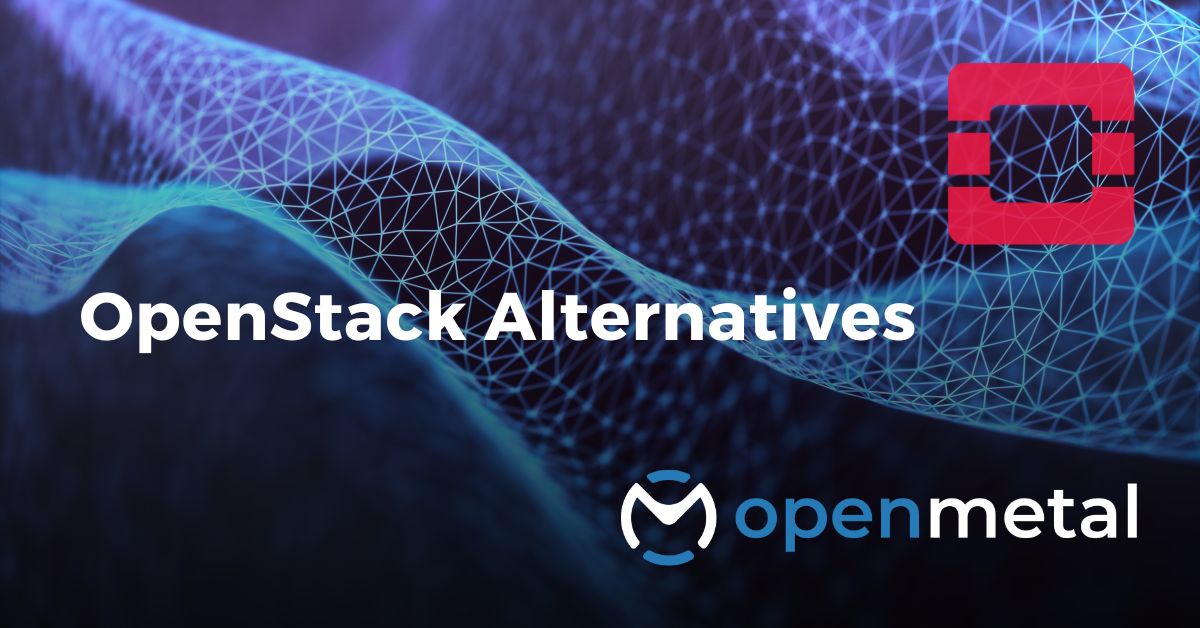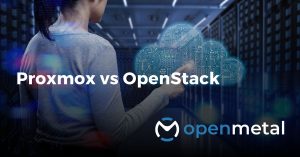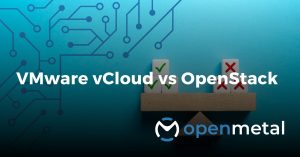
In this blog:
- What Is OpenStack?
- How Does OpenStack Work?
- What Are The Core OpenStack Projects?
- What Are The Pros Of Using OpenStack?
- Why Would Organizations Seek OpenStack Alternatives?
- OpenStack VS Apache CloudStack
- OpenStack vs Proxmox
- OpenStack vs VMware vCloud
- OpenStack vs GCP
- OpenStack vs AWS
- What Are The Benefits Of An On-Demand Private OpenStack Clouds?
- Is OpenStack The Right Environment For Your Workloads?
What is OpenStack?
OpenStack is a collection of open source software tools for creating and managing public, private or hybrid cloud. OpenStack clouds are built by integrating various software projects. Core projects usually included in OpenStack clouds are:
A virtual machine deployed with OpenStack can be implemented for a multitude of use cases. This includes software-as-a-service delivery, container deployments, heterogeneous compute, and web hosting. OpenStack is currently used by organizations such as Nike, Verizon, Bloomberg, T-Mobile, Walmart, Target, Volkswagen, Rakuten, Progressive, Overstock.com, and many more. Learn more about who is using OpenStack.
How Does OpenStack Work?
OpenStack is a platform composed of several independent components. These components interoperate with each other through Application Programming Interface (API). These components are complementary, but do not depend on all other components to function properly. This grants you the ability to build your cloud with only the components you need.
This feature is what attracts so many users to OpenStack. You can build your cloud with the projects you need for your workload and not waste hardware resources on additional components which are not necessary for the functionality you require in your cloud. This is something you cannot get with public clouds that do not give you access to configuration at the root level.

What Are The Core OpenStack Projects?

CINDER: provides block storage service, it is responsible for virtualizing block storage devices and provides storage volumes for your compute resources. This OpenStack project allows you to access resources without knowing where the storage is actually deployed or on what type of device it’s on. Cinder achieves this by using either reverence implementation or plugin drivers for other storage devices.
Cinder Block storage is similar to AWS EBS.
If you want to use Cinder, you will also need Keystone.

Keystone: is used for client authentication, authorization, and service discovery. Keystone supports various authentication protocols such as LDAP, OAuth, OpenID Connect, SAML, and SQL for authentication and authorization. It is used as the identity service in OpenStack. Many applications depend on Keystone, so if you’re building an OpenStack cloud, it’s likely you will need this project.
Keystone is similar to AWS IAM (Identity and Access Management).

GLANCE: provides the image management service in your cloud. It grants you the ability to discover, register, and retrieve virtual machines, Docker, and bare metal images.
Glance is similar to AWS Amazon Machine Images.

NEUTRON: is responsible for delivering networking-as-a-service in the cloud. It is an SDN networking project. Neutron is used to provision virtual networks, subnets, ports, routers, and a variety of advanced networking services.
Neutron is similar to AWS Networking.
If you want to use Neutron, you will also need Keystone.

NOVA: provides you with quick access to compute resources, including bare metal, virtual machines, and containers. Nova also allows you to provision and manage your virtual machines (instances). Most OpenStack clouds include the Nova project because it grants you access to massively scalable on-demand compute resources. Nova uses the services of the networking project Neutron to provision a network port for your instance. What makes Nova extra special is that it was one of the first two OpenStack projects to be developed and released. Nova was NASA’s contribution to the founding of OpenStack.
A Nova Instance is similar to AWS EC2.
If you would like to use Nova, you will also need: Glance, Keystone, Neutron and Placement.

Swift: is an object storage service that is highly available, distributed, and scalable. Swift is the project you would turn to if you want to store unconstructed data that can grow indefinitely because it allows you to store data efficiently, safely, and cheaply. This project was developed by RackSpace and is one of the two projects that OpenStack was launched with. Swift is similar to AWS S3. Learn more about AWS S3 alternatives.
What Are The Pros Of Using OpenStack?
When you consider the list of major industry players using OpenStack, it is not surprising that there are many pros to using OpenStack. These include:
- Easy Scalability: With OpenStack, you can scale your cloud up or down at a bare metal level. This is beneficial if you are in an industry that has peaks or downtimes. You will have access to additional resources when you need them and you only pay for them when you use them. This allows you to keep up with your customers’ demands without exceeding your budget.
- Affordable: Because OpenStack is open source, the source code is available freely for public use. It was released as open source under the Apache 2.0 license. However, you will still have hardware costs unless you use an OpenStack vendor.
- Easy Automation: OpenStack has tools that can make cloud management easier. OpenStack also has its own API which allows other programs to tap into it. Developers can create their own solutions to automate tasks and share them with the OpenStack community. With more than a decade of contributions from the open source community, there are various automation tools available.
- Reliable: The OpenStack software has been improved on for over a decade. It gives you a tried and true approach. Any use you can think of for OpenStack has probably been thought of, tried, and tested.
- Fast Development: If a new OpenStack feature is being developed, it can be quickly worked on by a team of expert developers from around the world. This allows OpenStack to keep up with the fast-paced tech world.
- Vendor-neutral: With OpenStack, you will never have to deal with vendor lock-in because it is open source! If you do opt to use an OpenStack provider, it is easy to switch between vendors.
Now, you may have a clear understanding of why so many organizations turn to OpenStack. But before jumping headfirst into OpenStack, let’s consider some of the cons.
Why Would Organizations Seek OpenStack Alternatives?
- Manual Installation: OpenStack is a suite of projects and each of those applications needs to be configured to your needs. You will need an OpenStack expert or team of experts depending on the size of your project. Additionally, you will need expensive hardware and your engineers’ time will be allocated to setting up your cloud for weeks. This is usually the deal breaker for many small to medium sized businesses that need all hands on deck. But notice I specified manual installation; there are ways to get OpenStack installed without doing it yourself that I will address later on in this post.
- Consistency: As the open source community continues to contribute, the OpenStack component suite is always in flux as new components are added and others are deprecated.
- Support: OpenStack is not owned or directed by any one vendor or team. So, no one is responsible for providing support on your uniquely configured cloud.
Apache CloudStack vs OpenStack
CloudStack an open-source platform that provides cloud infrastructure management solutions, including compute orchestration, network management, and storage provisioning. While it shares some similarities with OpenStack, CloudStack follows a different design philosophy and offers its own unique features.
CloudStack Key Features:
- All-in-One Approach: CloudStack takes an all-in-one approach, offering a more integrated solution out of the box. When implementing CloudStack, you receive a pre-packaged stack of services (compute, storage, networking and user management) that are designed to work seamlessly together. CloudStack simplifies the deployment process considerably, reducing the complexity and effort required for initial setup. While CloudStack’s all-in-one approach offers convenience and simplicity, it may be seen as somewhat less customizable compared to modular solutions like OpenStack.
- Simplified Deployment: As mentioned before the pre-packaged and pre-configured nature of CloudStack makes it easier to set up and deploy compared to OpenStack. This makes it a good choice for smaller organizations or those new to cloud technology. However, for organizations with very precise needs, this limits their ability to customize their infrastructure.
- Built-in Network Virtualization: CloudStack’s integrated network virtualization capabilities simplifies the process to set up and control the intricate networking requirements of a cloud environment.
- Strong Hypervisor Support: CloudStack supports multiple hypervisors, including KVM, VMware, and XenServer.
- User-Friendly UI: CloudStack offers a user-friendly web-based interface for management, which can be advantageous for those who prioritize ease of use.
OpenStack Key Features:
- Modular Architecture: OpenStack’s standout feature is its modular architecture, which provides users with the flexibility to customize their cloud infrastructure. This modular design means that organizations can selectively choose and configure specific components according to their unique requirements. For instance, they can opt for Compute (Nova) to manage virtual machines, Networking (Neutron) for network resources, and Storage (Cinder) to handle storage needs. This flexibility allows organizations to tailor their OpenStack deployment precisely to their operational needs, making it an attractive choice for those seeking a highly adaptable and fine-tuned cloud solution.
- Large and Active Community: OpenStack has a vast and active community of contributors and users, leading to frequent updates and improvements.
- Multi-Hypervisor Support: OpenStack also supports multiple hypervisors like KVM, VMware, and Xen, which makes it versatile for various environments.
- Vendor Support: OpenStack providers like OpenMetal offer On-Demand OpenStack-Based Private Clouds and commercial support and services for OpenStack deployments. These solutions offer many of the out of the box conveniences of CloudStack.
- Scalability: OpenStack’s architecture allows for horizontal scalability, which means that as the demands on the cloud infrastructure grow, additional servers, storage, and networking resources can be seamlessly added to the existing setup. This allows OpenStack to accommodate increasing workloads and expanding user demands.
CloudStack vs OpenStack: What sets them apart?
Complexity
OpenStack’s modular approach to cloud infrastructure offers a high degree of flexibility and customization, which makes it ideal for organizations with complex and varied needs. This allows users to cherry-pick specific components that align with their objectives, whether it’s compute, networking, or storage. Ex, a research institution may prioritize robust storage solutions, while an e-commerce giant may require scalable compute resources.
However, this flexibility comes at a cost – the complexity of setup and management. Configuring an OpenStack environment can be challenging for organizations seeking to build their own OpenStack deployment. This is even more challenging for those who are new to the platform or lack extensive IT expertise. Organizations who choose to not use an OpenStack provider will need skilled administrators or engineers to navigate the intricacies of integrating and maintaining different components. This can lead to longer deployment times and increased operational complexity.
Like the pre-built OpenStack clouds, CloudStack comes with a pre-configured stack of services, simplifying the setup process. This simplicity is advantageous for smaller businesses or those with limited resources for extensive customization and management.
However, this integrated approach may come at the cost of some flexibility compared to OpenStack’s modular design. Organizations that require highly specialized configurations or have unique infrastructure demands may find CloudStack’s one-size-fits-all approach less accommodating.
Community and Support
OpenStack is governed by the Open Infrastructure Foundation which has over 110,000 members in 187 countries. The thriving community surrounding OpenStack contributes significantly to its appeal as an open-source cloud solution. The community’s active development, extensive documentation, and collaborative nature provide users and organizations with valuable resources and support, enhancing the overall experience of working with OpenStack.
Integration
When it comes to integration, CloudStack and OpenStack offer distinct approaches, each with its own set of advantages.
CloudStack provides a more integrated and turnkey solution by default. With CloudStack, the components are pre-configured to work seamlessly together right out of the box, which can significantly expedite the initial cloud infrastructure setup.
On the other hand, OpenStack’s modular design empowers organizations with a high degree of customization. With OpenStack, you have the freedom to select and configure specific components like Compute (Nova), Networking (Neutron), and Storage (Cinder) to craft a cloud ecosystem that perfectly aligns with your unique requirements. This level of customization can be a game-changer, providing your organization with a competitive edge and ensuring that your cloud infrastructure is finely tuned to meet your business objectives.
Scalability
Both OpenStack and CloudStack are scalable cloud solutions, but OpenStack is often favored for large-scale enterprise environments. OpenStack’s modular architecture enables easy expansion and adaptation to growing workloads through the addition of resources and components. This scalability makes it well-suited for enterprises with dynamic, evolving needs, ensuring they can efficiently accommodate increased demands as their businesses grow.
OpenStack and CloudStack are both formidable open-source cloud management platforms, each with its strengths and specific use cases. While CloudStack may excel in simplicity and ease of use, OpenStack’s robustness, versatility, and large and active community make it the preferred choice for many organizations.
 Proxmox vs OpenStack
Proxmox vs OpenStack
Proxmox Virtual Environment was developed by Proxmox Server Solutions GmbH and combines two virtualization technologies: Kernel-based Virtual Machine (KVM) for full virtualization and Linux Containers (LXC) for lightweight container-based virtualization. Proxmox provides a user-friendly web-based interface that simplifies the creation, deployment, and management of virtual machines and containers. With Proxmox, users can achieve flexibility, efficiency and cost-effectiveness in managing their virtualized environments.
Proxmox Key Features:
- KVM and LXC Virtualization: Proxmox VE supports both KVM and LXC virtualization technologies, this dual-stack approach allows users to choose the most suitable virtualization method for their specific workloads.
- Web-Based Management Interface: Proxmox VE provides a user-friendly web-based interface that simplifies the management of virtual machines, containers, storage, and network configurations. This intuitive interface makes it easy for administrators to create, configure, and monitor virtualized environments without the need for complex command-line interactions.
- Storage Options: Proxmox VE offers flexible storage options, including support for local storage, NFS, Ceph, and more. The integrated storage management system allows you to easily add and manage storage resources, create storage pools, and implement features like live migration and backup to ensure data availability and redundancy.
- Backup and Disaster Recovery: Proxmox VE includes built-in backup and disaster recovery features, making it easy to create and schedule backups of virtual machines and containers. You can store backups locally or on remote servers, and Proxmox VE supports various backup methods, including full backups, incremental backups, and snapshots, ensuring data protection and rapid recovery in case of failures.
- High Availability (HA) Clustering: Proxmox VE supports HA clustering, allowing you to create highly available virtualization environments. With HA clustering, you can distribute virtual machines across multiple physical servers and ensure automatic failover in case of hardware or node failures. This feature is crucial for minimizing downtime and ensuring the continuous operation of critical applications.
OpenStack Key Features:
- Modular Architecture and Customization: OpenStack boasts a modular architecture, comprising a collection of distinct services, each catering to specific cloud infrastructure needs. This modular design provides users with the flexibility to select and customize the components that align with their unique requirements, making their OpenStack clouds highly customizable. This flexibility enables organizations to tailor their cloud infrastructure to meet specific requirements and use cases, whether it’s for private clouds, public clouds, or hybrid cloud environments.
- Comprehensive Set of Services: OpenStack provides a comprehensive suite of services for various cloud computing needs. Beyond the core services like compute, storage, and networking, OpenStack offers services for identity and access management (Keystone), dashboard and user interface (Horizon), telemetry and monitoring (Ceilometer), and more. This wide array of services makes it a one-stop solution for building a complete cloud environment.
- Scalability: OpenStack is designed to be highly scalable, capable of handling large-scale cloud deployments. It can grow with your organization’s needs, making it suitable for both small businesses and large enterprises. This scalability ensures that you can add resources and services as your workload increases.
- Multi-Tenancy: OpenStack supports multi-tenancy, allowing organizations to create and manage isolated environments for different users or departments within the same cloud infrastructure. This feature is crucial for service providers and enterprises that need to offer cloud services to multiple customers or teams securely.
Proxmox vs OpenStack: What sets them apart?
Scalability and Complexity: OpenStack’s modular architecture allows for greater flexibility and customization, making it adaptable to complex, multi-tenant environments. This makes it a great choice for enterprise or organizations seeking to isolate workloads from each other. Proxmox, on the other hand, is more streamlined and may be better suited for smaller-scale virtualization needs.
Multi-Tenancy: OpenStack’s robust support for multi-tenancy makes it an excellent option for organizations that need to isolate and manage resources for multiple users, customers, or departments within a single cloud infrastructure. This feature is crucial for service providers and enterprises with diverse user bases.
Integration and Compatibility: OpenStack’s focus on interoperability and compatibility with various hardware and software components can be advantageous. It allows organizations to integrate a wide range of technologies seamlessly. Proxmox on the other hand offers integration but may not provide the same level of flexibility and compatibility as OpenStack in more complex environments.
Enterprise-Grade Features: OpenStack offers enterprise-grade features such as advanced networking options, comprehensive identity and access management, and robust monitoring and telemetry tools. These features are essential for organizations with stringent security, compliance, and performance requirements.
Both OpenStack and Proxmox serve as robust solutions for virtualization and cloud management, the choice between them largely depends on specific use cases and organizational needs.
OpenStack stands out as a versatile and scalable cloud platform, offering a wide range of services and customization options suitable for complex, multi-tenant environments. Its open-source nature fosters innovation, making it a compelling choice for enterprises and service providers seeking control over their cloud infrastructure and the ability to tailor it to unique requirements.
In contrast, Proxmox excels in simpler virtualization scenarios, offering an intuitive interface and a more straightforward setup. Proxmox is ideal for smaller deployment for individual use. Ultimately, the decision between OpenStack and Proxmox should be guided by your organization’s specific use case, available resources, and the desired level of control and customization.
OpenStack VS VMware vCloud
VMware vCloud is a cloud platform that allows users to create, manage and deploy virtualized networks and services. vCloud is meticulously designed to provide astounding scalability and reliability which makes it’s a top choice for organizations seeking infrastructure that balances power and simplicity.
VMware vCloud Key Features:
- Enterprise-Grade Security – VMware vCloud is renowned for its robust security features. vCloud ensures the safety of data and applications within the cloud environment by using multi-layered defenses.
- Resource Optimization – VMware’s vCloud platform provides advanced resource optimization tools which enables users to seamlessly allocate and manage cloud resources including compute, storage and network resources.
- Scalability and Reliability – vCloud’s architecture allows for dynamic resource allocation across compute, storage and network resources. This allows organizations to scale their cloud environment efficiently.
- High Availability: vCloud has built in features that redirects traffic and resource to redundant systems if there is an interruption caused by hardware failures or network outages.
- Comprehensive Management Tools – VMware vCloud is equipped with a comprehensive suite of management tools which administrators can use to streamline operations, optimize resource usage, and ensure the smooth functioning of their cloud infrastructure.These tools provide a robust set of functionalities, including real-time monitoring, performance analysis, and optimization capabilities. Administrators can gain insights into resource utilization, identify potential bottlenecks, and make informed decisions to enhance infrastructure efficiency and performance.
OpenStack Key Features:
- Modular Architecture: OpenStack’s standout feature is its modular architecture, which provides users with the flexibility to customize their cloud infrastructure. This modular design means that organizations can selectively choose and configure specific components according to their unique requirements. For instance, they can opt for Compute (Nova) to manage virtual machines, Networking (Neutron) for network resources, and Storage (Cinder) to handle storage needs. This flexibility allows organizations to tailor their OpenStack deployment precisely to their operational needs, making it an attractive choice for those seeking a highly adaptable and fine-tuned cloud solution.
- Large and Active Community: OpenStack has a vast and active community of contributors and users, leading to frequent updates and improvements.
- Multi-Hypervisor Support: OpenStack also supports multiple hypervisors like KVM, VMware, and Xen, which makes it versatile for various environments.
- Vendor Support: OpenStack providers like OpenMetal offer On-Demand OpenStack-Based Private Clouds and commercial support and services for OpenStack deployments. These solutions offer many of the out of the box conveniences of CloudStack.
- Scalability: OpenStack’s architecture allows for horizontal scalability, which means that as the demands on the cloud infrastructure grow, additional servers, storage, and networking resources can be seamlessly added to the existing setup. This allows OpenStack to accommodate increasing workloads and expanding user demands.

GCP vs OpenStack
Google Cloud Platform (GCP) is a prominent player in the cloud computing landscape. Securing it’s position as one of the most popular public cloud solutions giving stiff competition to AWS and Microsoft Azure. GCP offers a suite of cloud computing services which provide a wide range of infrastructure and platform services for building, deploying, and managing applications and services in the cloud. Let explore how GCP measures up as an alternative solution to OpenStack.
Google Cloud Platform Key Features:
- Wide Range of Services: GCP offers various services including compute, networking, storage, big data, machine learning, and management. This allows their platform to fill the needs of diverse cloud computing requirements. This comprehensive suite of services ensures that businesses have the flexibility to choose the services that they need to build and run their applications.
Global Reach: GCP has a global network of data centers, which means that your applications can be accessed from anywhere in the world. This is important for businesses operating in regions where regulations require local data centers, like the European Union. It also allows businesses to have multi-region redundancy or choose to have their workloads hosted in cheaper regions.
Security: When it comes to safeguarding your valuable data against unauthorized access, GCP provides a range of robust security features. These features are designed to meet the stringent demands of the tech industry. GCP offers a suite of security measures, including Identity and Access Management (IAM), Key Management Service (KMS), and Security Command Center (SCC), which collectively work to fortify your data protection strategy.
Innovative Features: GCP constantly introduces new features and enhancements, enabling businesses to stay at the forefront of technology. This comprehensive suite of tools offered by GCP empowers businesses to harness the power of data, deploy scalable infrastructure, and leverage machine learning capabilities, among other cutting-edge functionalities.
OpenStack Key Features:
- Modular Architecture and Customization: OpenStack boasts a modular architecture, comprising a collection of distinct services, each catering to specific cloud infrastructure needs. This modular design provides users with the flexibility to select and customize the components that align with their unique requirements, making their OpenStack clouds highly customizable. This flexibility enables organizations to tailor their cloud infrastructure to meet specific requirements and use cases, whether it’s for private clouds, public clouds, or hybrid cloud environments.
- Comprehensive Set of Services: OpenStack provides a comprehensive suite of services for various cloud computing needs. Beyond the core services like compute, storage, and networking, OpenStack offers services for identity and access management (Keystone), dashboard and user interface (Horizon), telemetry and monitoring (Ceilometer), and more. This wide array of services makes it a one-stop solution for building a complete cloud environment.
- Scalability: OpenStack is designed to be highly scalable, capable of handling large-scale cloud deployments. It can grow with your organization’s needs, making it suitable for both small businesses and large enterprises. This scalability ensures that you can add resources and services as your workload increases.
- Multi-Tenancy: OpenStack supports multi-tenancy, allowing organizations to create and manage isolated environments for different users or departments within the same cloud infrastructure. This feature is crucial for service providers and enterprises that need to offer cloud services to multiple customers or teams securely.
AWS vs OpenStack
AWS establish the cloud computing industry and has dominated as a hyperscaler ever since. Amazon Web Services is a comprehensive and continuously evolving cloud platform. AWS provides highly reliable and scalable infrastructure. One of the key advantage of AWS is their tenure in the cloud computing domain which resulted in AWS innovating and improving their product for longer than their competitors.
Amazon Web Services Key Features:
- Comprehensive Service Portfolio: AWS provides extensive catalog of services which caters to diverse cloud computing needs, ensuring that organizations have access to the tools necessary to build, deploy, and manage their applications effectively. These services include: computing, storage, databases, analytics, security, and more.
Global Infrastructure: AWS has data centers across multiple geographic regions, therefore, AWS can offer global reach and low-latency access to applications and services. This access to global infrastructure allows organizations to deploy resources closer to end-users, which will in turn result optimal performance and helps organizations stay compliant with regional specific data sovereignty regulations such as GDPR.
Reliability and High Availability: AWS has a highly reliable infrastructure with built-in redundancy and failover mechanisms. These help to ensure uninterrupted service availability. This includes multiple availability zones within each region, data replication across geographically dispersed locations, and industry-leading service level agreements (SLAs) guaranteeing uptime and performance.
Scalability and Flexibility: With AWS, organizations have the flexibility to scale their resources up or down based on demand, without upfront hardware investments. Whether it’s auto-scaling capabilities, flexible pricing models, or support for hybrid cloud deployments, AWS provides the agility and scalability businesses need to adapt to changing requirements. However, it’s important to not that this ease of access often leads to over consumption of resources and users can be surprised by run away bills. Auto-scaling should be set with budgetary caps to avoid expected bills.
OpenStack Key Features:
- Modular Architecture and Customization: OpenStack boasts a modular architecture, comprising a collection of distinct services, each catering to specific cloud infrastructure needs. This modular design provides users with the flexibility to select and customize the components that align with their unique requirements, making their OpenStack clouds highly customizable. This flexibility enables organizations to tailor their cloud infrastructure to meet specific requirements and use cases, whether it’s for private clouds, public clouds, or hybrid cloud environments.
- Comprehensive Set of Services: OpenStack provides a comprehensive suite of services for various cloud computing needs. Beyond the core services like compute, storage, and networking, OpenStack offers services for identity and access management (Keystone), dashboard and user interface (Horizon), telemetry and monitoring (Ceilometer), and more. This wide array of services makes it a one-stop solution for building a complete cloud environment.
- Scalability: OpenStack is designed to be highly scalable, capable of handling large-scale cloud deployments. It can grow with your organization’s needs, making it suitable for both small businesses and large enterprises. This scalability ensures that you can add resources and services as your workload increases.
- Multi-Tenancy: OpenStack supports multi-tenancy, allowing organizations to create and manage isolated environments for different users or departments within the same cloud infrastructure. This feature is crucial for service providers and enterprises that need to offer cloud services to multiple customers or teams securely.
What Are The Benefits Of An On-Demand Private Cloud Hosted On OpenStack?
OpenMetal provides you with a production-ready hosted private cloud in less than 45 seconds. OpenMetal clouds come with OpenStack backed by Ceph storage and all core services we recommend for efficient day 2 operations.
OpenMetal clouds are hosted on hardware allocated specifically to your cloud but we take care of managing the hardware. You get a private cloud at the speed and convenience of a public cloud.
Additionally, we do not charge by CPU, GPU, RAM, or storage usage. With OpenMetal, you pay for a block of physical hardware resources (with defined CPU/RAM/Storage or GPU, etc) and you can use them as much as you want as long as you are within the limitation of your server’s hardware resources. Each cloud has the ability to host 10s – 1000s of virtual machines (VM) and you determine how much resource to allocate to each VM. You can spin up and down VMs as you need with no impact on your bill.
Customers switching to OpenMetal from the public cloud have seen their cloud bills reduce by 50%. You can learn more about our customers and their experience moving to OpenMetal via our case studies.
Is OpenStack The Right Environment For Your Workloads?
The only way you can be sure that OpenStack is the right environment to run your workloads is by running workloads in OpenStack. And you can do so at no cost to yourself. OpenMetal allows individuals and organizations to test our clouds to learn more about OpenStack and see if the environment is the right fit for you without having to dedicate time and resources to build your own OpenStack cloud. You can test your workloads in OpenStack by signing up for a free trial.
More on the OpenMetal Blog…

AWS vs GCP: Choosing The Right Cloud Platform
AWS and GCP are leading players in cloud computing, offering a wide range of services and attractive pricing. However, choosing the right platform requires understanding their strengths, customer pain points, and alternatives. Comparing and shopping around for cloud products can be complex, with varying names and pricing structures…Read More

Cloud cost optimization is the practice of efficiently managing the cost of your business’ cloud computing resources. An effective cloud cost optimization strategy ensures that your business gets the best value from its cloud investments. This strategy will find the right balance between performance, cost, compliance, and security for each workload or application your …Read More

Comparing Public, Private and Alternative Clouds- Which Is Right For Your Organization?
With public and private clouds as the traditional options, innovative alternative clouds have emerged and are making waves. Deciding which cloud to use for your organization requires careful consideration of factors such as your unique business needs, budget, security and compliance requirements, and other important factors… Read More
Test Drive
For eligible organizations, individuals, and Open Source Partners, Private Cloud Cores are free to trial. Apply today to qualify.
Subscribe
Join our community! Subscribe to our newsletter to get the latest company news, product releases, updates from partners, and more.




































 Proxmox vs OpenStack
Proxmox vs OpenStack

